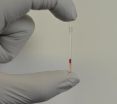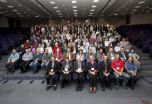(Press-News.org) WASHINGTON (Sept. 1, 2014) — People with fat around their abdominal area are at greater risk of developing hypertension when compared to those with similar body mass index but fat concentrations elsewhere on the body, according to a study published today in the Journal of the American College of Cardiology.
Obesity is a known risk factor for hypertension, or high blood pressure, and it is widely reported that the location of fat on a person's body can lead to increased risk of other health issues like heart disease and cancer. However, the relationship between hypertension and overall obesity versus site-specific fat accumulation is unclear.
For this study, 903 patients enrolled in the Dallas Heart Study were followed for an average of seven years to track development of hypertension. Hypertension was classified as a systolic blood pressure of greater or equal to 140, diastolic blood pressure of greater or equal to 90, or initiation of blood pressure medications. Patients also received imaging of visceral fat, or fat located deep in the abdominal cavity between the organs; subcutaneous fat, or visible fat located all over the body; and lower-body fat.
"Generally speaking, visceral fat stores correlate with the 'apple shape' as opposed to the 'pear shape,' so having centrally located fat when you look in the mirror tends to correlate with higher levels of fat inside the abdomen," said senior author Aslan T. Turer, M.D., M.H.S., a cardiologist at the University of Texas Southwestern Medical Center in Dallas.
At the end of the study period, 25 percent of patients developed hypertension. While higher BMI was associated with increased incidence of hypertension, when abdominal fat content, overall fat content and lower-body fat content were factored in, only abdominal fat remained independently associated with hypertension. The relationship between abdominal fat and hypertension did not change when factoring in gender, age or race.
The strongest correlation between abdominal fat and hypertension was observed with retroperitoneal fat, which is a type of visceral fat located behind the abdominal cavity and largely around the kidneys.
"The high incidence of hypertension and presence of retroperiotoneal fat could suggest that the effects from fat around the kidneys are influencing the development of hypertension," Turer said. "This link could open new avenues for the prevention and management of hypertension. The finding of the fat around the kidney is a novel one and we do not know specifically what the 'in the mirror' correlates are."
INFORMATION:
The American College of Cardiology is a 47,000-member medical society that is the professional home for the entire cardiovascular care team. The mission of the College is to transform cardiovascular care and to improve heart health. The ACC leads in the formation of health policy, standards and guidelines. The College operates national registries to measure and improve care, provides professional medical education, disseminates cardiovascular research and bestows credentials upon cardiovascular specialists who meet stringent qualifications. For more information, visit cardiosource.org/ACC.
The Journal of the American College of Cardiology, which publishes peer-reviewed research on all aspects of cardiovascular disease, is the most widely read cardiovascular journal worldwide. JACC is ranked No. 1 among cardiovascular journals worldwide for its scientific impact.
Location of body fat can increase hypertension risk
Abdominal fat more strongly associated with high blood pressure risk than overall obesity
2014-09-01
ELSE PRESS RELEASES FROM THIS DATE:
Ride-sharing could cut cabs' road time by 30 percent
2014-09-01
CAMBRIDGE, Mass-- Cellphone apps that find users car rides in real time are exploding in popularity: The car-service company Uber was recently valued at $18 billion, and even as it faces legal wrangles, a number of companies that provide similar services with licensed taxi cabs have sprung up.
What if the taxi-service app on your cellphone had a button on it that let you indicate that you were willing to share a ride with another passenger? How drastically could cab-sharing reduce traffic, fares, and carbon dioxide emissions?
Authoritatively answering that question ...
Faster, cheaper tests for sickle cell
2014-09-01
Within minutes after birth, every child in the U.S. undergoes a battery of tests designed to diagnose a host of conditions, including sickle cell disease. Thousands of children born in the developing world, however, aren't so lucky, meaning many suffer and die from the disease each year.
A.J. Kumar hopes to put a halt to at least some of those deaths.
A Post-Doctoral Fellow in Chemistry and Chemical Biology working in the lab of George Whitesides, the Woodford L. and Ann A. Flowers University Professor, Kumar and colleagues, including other co-authors, have developed ...
Training your brain to prefer healthy foods
2014-09-01
BOSTON (September 1, 2014, 10:20 AM EDT) — It may be possible to train the brain to prefer healthy low-calorie foods over unhealthy higher-calorie foods, according to new research by scientists at the Jean Mayer USDA Human Nutrition Research Center on Aging (USDA HNRCA) at Tufts University and at Massachusetts General Hospital. Published online today in the journal Nutrition & Diabetes, a brain scan study in adult men and women suggests that it is possible to reverse the addictive power of unhealthy food while also increasing preference for healthy foods.
"We don't start ...
Fruit consumption cuts CVD risk by up to 40 percent
2014-09-01
Barcelona, Spain – Monday 1 September 2014: Daily fruit consumption cuts the risk of cardiovascular disease (CVD) by up to 40%, according to research presented at ESC Congress today by Dr Huaidong Du from Oxford, UK. The findings from the seven year follow-up study of nearly 0.5 million people in the China Kadoorie Biobank found that the more fruit people ate, the more their risk of CVD declined.
Dr Du said: "CVD, including ischaemic heart disease (IHD) and stroke, is the leading cause of death worldwide. Improving diet and lifestyle is critical for CVD risk reduction ...
Permanent AF doubles risk of stroke compared to paroxysmal AF
2014-09-01
Barcelona, Spain – Monday 1 September 2014: Permanent atrial fibrillation (AF) doubles the risk of stroke compared to paroxysmal AF, according to research in more than 6 000 patients presented at ESC Congress today by Dr Thomas Vanassche from Belgium. The findings suggest that a simple clinical assessment of the type of AF can help doctors to better estimate stroke risk.
Ischaemic stroke is the second cause of death in the EU, accounting for over a million deaths and many more disabled patients each year. Annual direct health care costs amount to more than €20 billion. ...
A nucleotide change could initiate fragile X syndrome
2014-09-01
Researchers reveal how the alteration of a single nucleotide—the basic building block of DNA—could initiate fragile X syndrome, the most common inherited form of intellectual disability. The study appears in The Journal of Cell Biology.
Fragile X syndrome is caused by a defect in a gene on the X chromosome called fragile X mental retardation 1 (FMR1). Around 1 in 230 women and 1 in 360 men carry a so-called premutation, in which a series of DNA repeats at one end of the FMR1 gene is slightly longer than normal. These repeats are prone to even further expansion when ...
Scientists call for investigation of mysterious cloud-like collections in cells
2014-09-01
WASHINGTON — About 50 years ago, electron microscopy revealed the presence of tiny blob-like structures that form inside cells, move around and disappear. But scientists still don't know what they do — even though these shifting cloud-like collections of proteins are believed to be crucial to the life of a cell, and therefore could offer a new approach to disease treatment.
In the Journal of Cell Biology, two researchers are issuing a call to investigators from various backgrounds, from biophysics to cell biology, to focus their attention on the role of these formations— ...
Zooming in for a safe flight
2014-09-01
As nocturnal animals, bats are perfectly adapted to a life without light. They emit echolocation sounds and use the delay between the reflected echoes to measure distance to obstacles or prey. In their brains, they have a spatial map representing different echo delays. A study carried out by researchers at Technische Universität München (TUM) has shown for the first time that this map dynamically adapts to external factors.
Closer objects appear larger
When a bat flies in too close to an object, the number of activated neurons in its brain increases. As a result, ...
Week-long meeting on naming algae, fungi, and plants recorded for posterity
2014-09-01
The week-long discussions and decisions of the Nomenclature Section of the XVIII International Botanical Congress took place in Melbourne, Australia in July 2011. This meeting is held every six years and it is where the world's premier experts on the rules for naming algae, fungi and plants get together to debate and update the rule book for naming the organisms they study. This is the primary product of the meeting, the International Code of Nomenclature for algae, fungi, and plants, which was published in 2012. The other important product is the official report for the ...
Scientists get set for simulated nuclear inspection
2014-09-01
Some 40 scientists and technicians from around the world will descend on Jordan in November to take part in a simulated on-site inspection of a suspected nuclear test site on the banks of the Dead Sea.
Playing the part of inspectors, the experts will have access to a wide range of sensor technologies to look for signs of whether a nuclear explosion has taken place. At the same time, other role-players representing the state under inspection will try to put them off their scent.
The aim of this elaborate exercise, as science writer Edwin Cartlidge explains in this month's ...
LAST 30 PRESS RELEASES:
COVID-19 booster immunity lasts much longer than primary series alone, York University-led study shows
Bentham Science joins United2Act
When thoughts flow in one direction
Scientists identify airway cells that sense aspirated water and acid reflux
China’s major cities show considerable subsidence from human activities
Drugs of abuse alter neuronal signaling to reprioritize use over innate needs
Mess is best: disordered structure of battery-like devices improves performance
Skyrmions move at record speeds: a step towards the computing of the future
A third of China’s urban population at risk of city sinking, new satellite data shows
International experts issue renewed call for Global Plastics Treaty to be grounded in robust science
Novel material supercharges innovation in electrostatic energy storage
A common pathway in the brain that enables addictive drugs to hijack natural reward processing has been identified by Mount Sinai
China’s sinking cities indicate global-scale problem, Virginia Tech researcher says
Study finds potential new treatment path for lasting Lyme disease symptoms
Metabolic health before vaccination determines effectiveness of anti-flu response
Department of Energy announces $16 million for traineeships in accelerator science & engineering
MRE 2024 Publication of Enduring Significance Awards
UCalgary researchers quantify the connection between homelessness and mental health disorders
Fourteen years after the Gulf of Mexico oil spill, endemic fishes face an uncertain future
For more open and equitable public discussions on social media, try “meronymity”
Marine microbial populations: Potential sensors of the global change in the ocean
Metacognitive abilities like reading the emotions and attitudes of others may be more influenced by environment than genetics
Salk Professor Satchin Panda named 2023 AAAS fellow
New urine test has higher diagnostic accuracy for prostate cancer
Floating solar’s potential to support sustainable development by addressing climate, water, and energy goals holistically
Drawing a line back to the origin of life
Data-driven music: Converting climate measurements into music
Palaeontology: Discovery of new ancient giant snake in India
Racial discrimination and metabolic syndrome in young Black adults
Adherence to American Cancer Society nutrition and physical activity guidelines among cancer survivors
[Press-News.org] Location of body fat can increase hypertension riskAbdominal fat more strongly associated with high blood pressure risk than overall obesity




